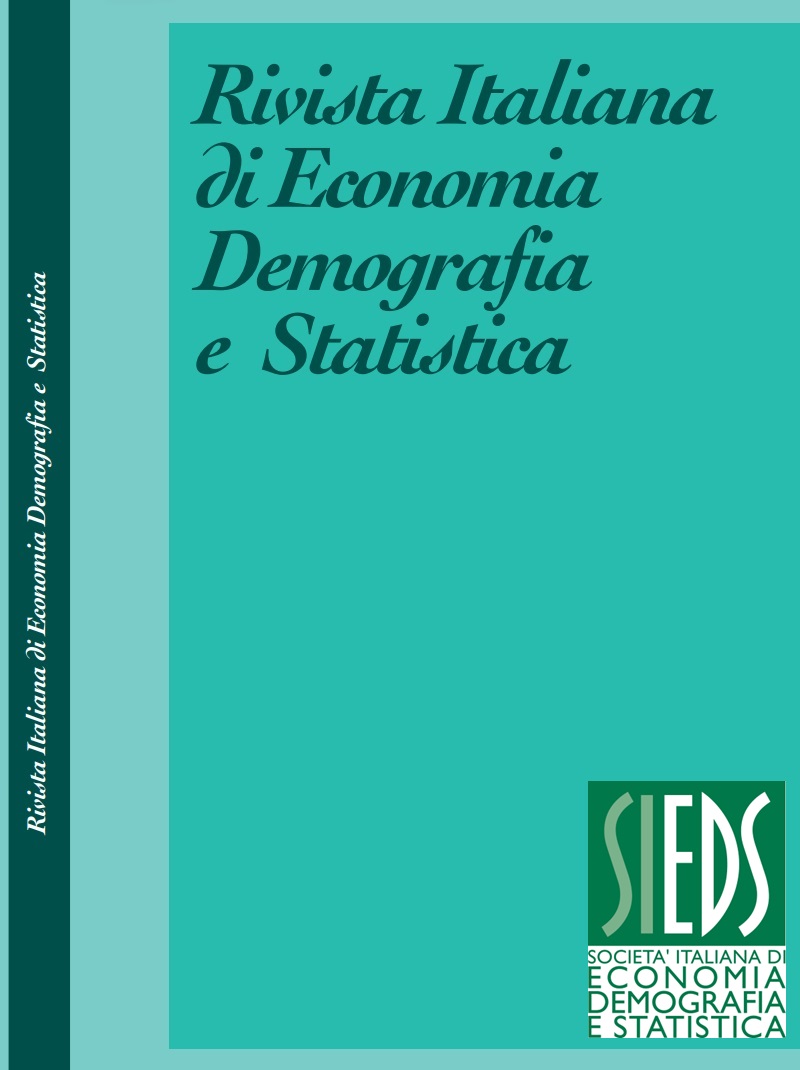Small Area Estimation of Poverty Indicators
DOI:
https://doi.org/10.71014/sieds.v79i3.345Keywords:
Small Area Estimation, Poverty indicatorsAbstract
ISTAT has been carrying out extensive research to implement Small Area Estimation (SAE) methods for computing Sustainable Development Goals (SDGs) indicators related to health, occupational status, gender equality, and poverty. This work aims to present the main results obtained applying some SAE methods to estimate the "At Risk of Poverty" indicator for unplanned domains using EU-SILC data. The sub-domains of interest are the provinces (NUTS3) and metropolitan cities, while the survey is designed to provide estimates up to the NUTS2 level (regions). The Small Area Estimation (SAE) methods considered encompass both area and unit-level mixed models, and their results are compared against each other. Administrative data sourced from ISTAT's Integrated System of Registers (ISR), specifically from the Population Register and the Labour Register, integrated with income-related administrative data, are used to specify the models. Furthermore, with direct estimates and administrative auxiliary information available from 2017 to 2021, SAE methods can borrow strength not only from other areas but also from various survey cycles. A final step in the process of estimating small-area statistics through an inferential model-based approach is establishing coherence between estimations of the target indicator computed at various levels of granularity. It is performed to align SAEs with precise and unbiased direct estimates computed at higher planned domain levels. This final calibration is not merely cosmetic. It is essential to meet user requirements on coherence and also to enhance the overall accuracy and reliability of model-based SAEs. The application of Small Area Estimation (SAE) estimates allows gains of efficiency compared to direct estimates.
References
BALDI C., CECCARELLI C., GIGANTE S., PACINI S., ROSSETTI F. 2018. The Labour Register In Italy: The New Heart Of The System Of Labour Statistics, Rivista Italiana di Economia, Demografia e Statistica, Vol. LXXII, No. 2, pp. 95-105.
BATTESE G. E., HARTER R. M., FULLER W. A. 1988. An error components model for prediction of county crop area using survey and satellite data, Journal of the American Statistical Association, Vol. 83, pp. 28-36. DOI: https://doi.org/10.1080/01621459.1988.10478561
DEVILLE J. C., SÄRNDAL C. E. 1992. Calibration estimators in survey sampling, Journal of the American Statistical Association, Vol. 87, No. 418, pp. 376-382. DOI: https://doi.org/10.1080/01621459.1992.10475217
FAY R. E. AND HERRIOT R. A. 1979. Estimates of income for small places: An application of James-Stein procedures to census data, Journal of the American Statistical Association, Vol. 74, No. 366, pp. 269-277. DOI: https://doi.org/10.1080/01621459.1979.10482505
HARMENING S., KREUTZMANN Ann-K., Salvati N., Schmid S. 2023. A Framework for Producing Small Area Estimates Based on Area-Level Models in R, The R Journal, Vol. 15, pp. 316-341. DOI: https://doi.org/10.32614/RJ-2023-039
OSIER G. 2009. Variance estimation for complex indicators of poverty and inequality using linearization techniques, Survey Research Methods, Vol. 3, No. 3, pp. 167-195.
REGULATION (EU) 2019/1700 OF THE EUROPEAN PARLIAMENT AND OF THE COUNCIL establishing a common framework for European statistics relating to persons and household. 2019. Official Journal of the European Union. LI 261/1
RAO J.N.K., MOLINA I. 2015. Small Area Estimation. Wiley Series. DOI: https://doi.org/10.1002/9781118735855
RAO J. N. K., YU M. 1994. Small-Area Estimation by Combining TimeSeries and Cross-Sectional Data, The Canadian Journal of Statistics, Vol. 22, No. 4, pp. 511–528. DOI: https://doi.org/10.2307/3315407
Downloads
Published
Issue
Section
License
Copyright (c) 2025 Michele D'Alò, Danila Filipponi, Stefano Gerosa, Francesco Isidori

This work is licensed under a Creative Commons Attribution 4.0 International License.



